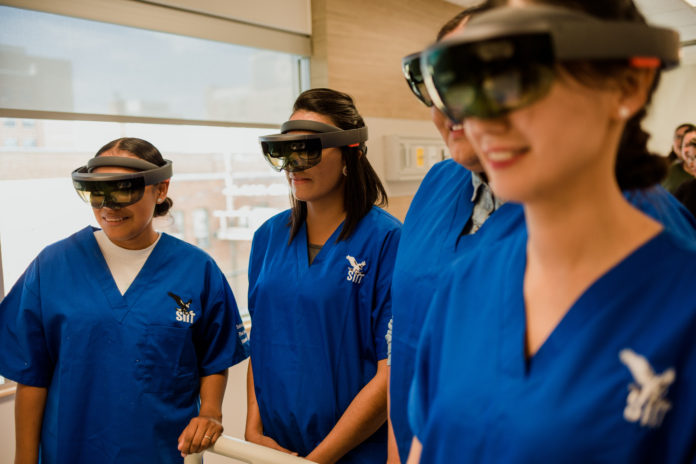
The Saskatchewan Indian Institute of Technologies (SIIT) will celebrate its first graduating class from its two-year Indigenous Practical Nursing (IPN) program this upcoming June.
As one of Saskatchewan’s four accredited institutions, SIIT is the only Indigenous institution in the province capable of offering certificates, diplomas, and degrees to its 90 per cent Indigenous student body.
Aligned with the Saskatchewan Association of Licensed Practical Nurses, the program prepares students to work in Western health-care facilities and offers licensing exams for nursing while incorporating Indigenous practices, including smudging and drum-making.
Development of the IPN program began in 2015, with the first class starting in 2019. It emerged with the intention to create a truly Indigenous program with First Nations leadership and perspectives on health care.
According to Tavia Laliberte, vice president of academics, Indigenous health care training is offered by organizations and institutions across Canada. But, she said, these curriculums are often designed from a Western perspective.
“We’ve really had the privilege at SIIT to build our programs right from an Indigenous perspective,” said Laliberte, who is Métis.
With the 13 Indigenous communities in Saskatchewan represented by the 14 students currently enrolled, the program goes beyond offering standard training for Indigenous nurses, and relates the training to the specific Indigenous needs and backgrounds of each student’s community.
Among the 14 students is Jillesa Sanderson, who is Cree from the James Smith Cree Nation east of Prince Albert, Sask. and will be graduating in June. The program’s Indigenous component is an asset that Sanderson said has benefited her experience in receiving the necessary skills, tools, and training for her nursing career.
“It just feels like I am getting the learning as a practical nurse with some Indigenous teachings too so that I can relate that with my Indigenous patients,” Sanderson said.
There is a significant gap in the number of Indigenous health professionals available to serve their own communities, with only 3 per cent of the registered nursing workforce in Canada being Indigenous, while Indigenous people make up almost 5 per cent of the total population.
In 2015, the health section of the Truth and Reconciliation Commission of Canada called for an increase in the number of Indigenous professionals working in health care and mandatory cultural competency training for all health-care professionals.
Sanderson said she intends to offer her Indigenous patients the cultural practices they require in health care and to always respect other Indigenous cultures. As a long-term goal, Sanderson said she hopes to bring everything she has learned back to her own community.
“It’s learning from each other and teaching each other as well, and I think it is a privilege to represent my own community back home,” Sanderson said.
Program coordinator and former instructor Valerie McLeod, who is Woodland Cree from the Lac La Ronge Indian Band in La Ronge, Sask., stressed the value of encouraging students to bring their own Indigenous culture and practices to the table, which provides an opportunity for instructors to learn from their students.
“Everything that I’ve done in my Indigenous courses is always tailored to each student individually because we want them to grow as individuals,” McLeod said. “It’s all about them self-identifying, taking their own knowledge that they’ve learned in their community from their families and being able to bring that as their tools to be more of those holistic care providers.”
Laliberte stressed the importance of technology in the program, such as the mannequins used with augmented and virtual reality (AVR) technology to simulate childbirth.
“We incorporated technology, not only into the Western perspective of health and well-being, but also into the Indigenous perspective,” Laliberte said. “It’s just something we’re quite proud of. It was quite an investment and I think it really was necessary for the success of the program.”
Victoria Lamb Drover, director of strategic communications at SIIT, is looking at the possibility of expanding the program beyond SIIT. While meeting varying provincial requirements and tailoring to the diverse needs of other Indigenous communities could be complicated, Drover said that other institutions have begun implementing similar curriculums and reaching out to SIIT for guidance.
With a similar Indigenous practical nursing program now being offered on Manitoulin Island in Ontario, in partnership between Fleming College in Peterborough, Ont. and Kenjgewin Teg, a post-secondary institution in M’Chigeeng First Nation on Manitoulin Island, Drover said she is pleased to see other institutions following in the steps of SIIT.
“We are excited to be the pioneers in this particular field,” Drover said. “We are happy to see that one of our sister institutions in Ontario is also taking up the charge.”
Sanderson said she feels that the nature of the IPN program could prove successful to other Indigenous nursing students throughout Canada and that the interest expressed by other institutions is a “positive step forward.”
“This program certainly has the ability to be delivered more and in other locations across the province,” Laliberte said, “so we’re really eager to see its success and figure out ways to be able to meet needs of other Indigenous communities across Canada.”
Featured image provided by the Saskatchewan Indian Institute of Technologies.





